Tech
Rebuilt engines: DIY vs Pro and Junkyard vs JDM
By Joel Moranton for 4Low Magazine, also published on Yota1
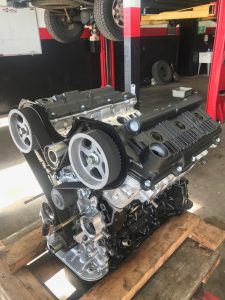 It used to be one of my life goals to rebuild an engine myself, to have that knowledge and pride of knowing that my engine was built by me – the right way. It was not until I started researching more and learned all the little details that go into an engine rebuild that I thought maybe I should leave this to the professionals. Over my years of modifying vehicles, I have learned that some things should not be done in a hobbyist’s garage. Not that they cannot be done or that they won’t get the job done, but sometimes there are special tools and knowledge that only come from years of experience. I want to walk you through what I have learned about rebuilding engines and a little warning about JDM engines.
It used to be one of my life goals to rebuild an engine myself, to have that knowledge and pride of knowing that my engine was built by me – the right way. It was not until I started researching more and learned all the little details that go into an engine rebuild that I thought maybe I should leave this to the professionals. Over my years of modifying vehicles, I have learned that some things should not be done in a hobbyist’s garage. Not that they cannot be done or that they won’t get the job done, but sometimes there are special tools and knowledge that only come from years of experience. I want to walk you through what I have learned about rebuilding engines and a little warning about JDM engines.
If you don’t have time to read the whole article, skip to the wrap-up at the end.
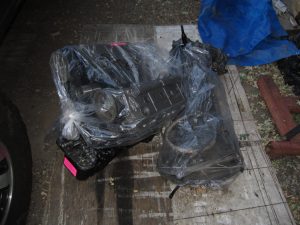
Now if you are reading this, you are probably in research mode yourself. Trying to find the most cost-effective way to get your vehicle back on the road. I, too, am always on a tight budget looking to squeeze every dollar. That’s why I purchased and installed a JDM low mileage engine by myself to replace my high mileage 5VZ. I thought it would just reset the clock to my low mileage days. To save money was why I turned the wrenches myself to replace the head gaskets on that JDM 5VZ when it failed. I thought doing the job myself, I would always come out ahead. My labor is free, right? So, when that engine didn’t pass smog due to a bad value, I likely caused that. All are trying to save a few bucks; where am I now? I’m about to pull the engine for the 3rd time because that junkyard engine, again, did not reset my clock. I have learned my lesson, I have done the research, I have read the reviews, and I decided to purchase a professionally rebuilt engine from Yota1 Performance.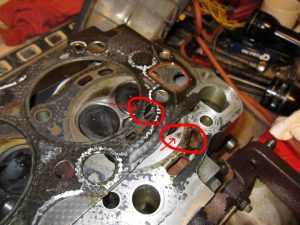
There is one more avenue that I thought of and could have explored before going to a professionally rebuilt engine, and that is rebuilding that junkyard engine myself. Something I used to lay awake at night wishing I had rebuilt my original engine instead of wasting time and money on the JDM engine. So, when I decided that the junkyard engine was not long for this world, I started some deep research. How to rebuild an engine? Thousands of people rebuild their engines in their garages every day; how hard could it be? Not that hard, actually; rebuilding an engine is not much harder than any other mechanical work. It is just turning wrenches and installing parts. Many have great success in rebuilding their own engines. Is it possible to rebuild your engine in your garage so it lasts 300,000 more miles? 100%, but for every person who has the knowledge, tools, and luck to rebuild an engine with great success, there are nine others on the side of the road. Ask yourself this, if you are reading a vehicle for sale ad and it reads, “I rebuilt the engine myself,” would you buy that vehicle? Before I did my research, I might have purchased that vehicle, but now knowing what I know, never.

Here is why, the amount of knowledge and special tools that go into rebuilding an engine the right way is just overwhelming. That is why this article is going to be super long, and I hope you read it until the end. When I found out how much machine work goes into a proper engine rebuild, and I priced out having that done at a local machine shop, I was already over halfway to the price of a professionally rebuilt engine. Then you must source all the parts for the rebuild with properly matched parts to the machine work that has been done; more on this later. How about just cleaning all the parts that are going to be reinstalled? Do you have access to a hot parts washer? Then after you have spent hours cleaning all the parts, do you know the little details to look for as evidence that the part needs to be replaced? Sure, you can, and I have looked over pages of manuals and forum posts to learn proper wear patterns on a camshaft or where to look for cracks. Then are you rebuilding this yourself to save money? Are you going to cheap out on the quality of the parts? If you want this build to last, it’s not the best idea to buy cheap parts. How about tools? I am sure 99.9% of you reading this would not have access to all the machinist equipment and would have to get it done at a local machine shop. So how do you know the machine shop knows the ins and out of that engine? Do they know the proper factory specification for the Surface Roughness Average for every engine they work on? If you were like me, Roughness Average was not even a term you had heard of, let alone something you knew you should ask of a machinist.

When I did my head gasket, I had my cylinder heads surfaced and pressure tested, but I don’t remember any mention of a Roughness Average. I do remember him showing me some cracks and telling me that it was fine to reuse because they pressure-tested great. Maybe those cracks were ok since they held pressure, and it is fine for some engines, but on the 5VZ, I should not have reused those. You must trust that the machine shop you choose has specific knowledge of the engine you are working on. Let’s say you were smarter than me and did not reuse those original heads and purchased new heads. That is a big chunk of your budget that was unforeseen, and you still owe the machine shop for doing that work. Did you buy cheap heads off eBay or quality heads from a reliable source? Either way, that money could have gone to a quality engine rebuilder that knows that engine from top to bottom. If I had just started this whole process by buying a quality rebuilt engine from a highly-rated engine builder, I would have been hundreds of dollars and many hours ahead.

Still not convinced to buy a rebuilt engine and still want to rebuild one yourself? Let us dive deeper into rebuilding an engine. I am mainly going to talk about the 5VZ Toyota engine since that is what I have and purchased from Yota1 Performance. Also, I will be referencing what Yota1 does to all their engines because all the little details that they do to an engine are what allow them to have such a great reputation for longevity. It is these little details if you do decide to rebuild yourself, that you should do as well. However, you would likely spend more time and money doing it all than it is worth, but that is for you to decide.
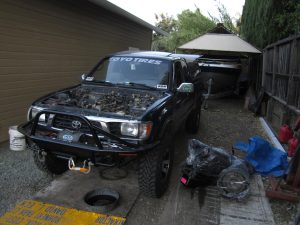
Before we get into all the steps of rebuilding an engine, this is a good place to talk about JDM engines. If you are thinking about getting a JDM (Japanese Domestic Market) or even a USA junkyard engine and dropping it in without rebuilding, you have about a 50/50 chance of it not being any good. Most JDM engine sellers will tell you that the engine is under 75,000 miles and was running when it was pulled. Sounds great, and that is what I originally did, and several others have done. It can be great if the original owner took care of their vehicle, but Japanese car owners tend not to keep their vehicles as long as we do here in the States. I learned while replacing the head gasket of my JDM engine that it had previously overheated and had been repaired once before. There was no way of knowing that until I tore it apart. However, take a few minutes to look under the hood of ANY vehicle (even a bottom-of-the-barrel commuter car) with 75,000 miles and tell me what you see. You will find an engine that has never leaked a drop of anything, or at least not much of anything, and it will look new because it basically is.
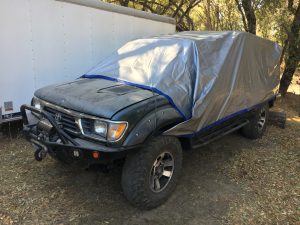
So, knowing what a low mileage engine typically looks like, why is it that most JDM engines you see sold have a heavy layer of oily crud all over them? It doesn’t make sense, does it? It could also be low mileage but high hours. My point is most JDM engines cannot be low-mile engines, even if they claim to be. There is no way to prove that the engine is actually low mileage. So now that we know that we could be misled on the mileage, are they even from Japan? There sure seem to be an awful lot of 20-year-old vehicles with less than 75,000 miles in Japan. I know they don’t drive as much as we do, but that’s under 4,000 miles a year. After trying and failing with JDM, I went with the USA engine from a friend’s junkyard. It had about 200,000 miles, and I heard it run before pulling it, but it had its own issues. Make sure to do your research and be careful if this is your only vehicle and you are looking to quickly replace an engine on the cheap. I have been in your shoes, and I wish I would have saved a bit more money and gone with a quality rebuilt engine.
There is a rumor about the 5VZ JDM engine that I have been unable to confirm, but it does seem likely. The rumor is that in Japan, the 5VZ was not available or was rare in passenger vehicles. The 5VZ engine in Japan is used in commercial vehicles, and commercial vehicles have their engines replaced every five years. With the owners knowing that the engine is only going to be used for five years, they simply don’t do maintenance on them. The reason I believe this is likely is if you search for images of JDM 5VZ, most have oil pans that are rear sump pans that would not fit in an IFS vehicle like the Prado or Surf. If you have knowledge about this, please send me an email so I can update this information. [email protected]
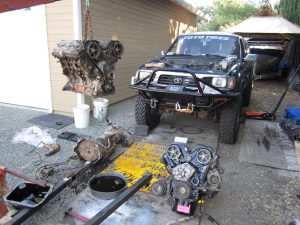
At the time of this article, JDM engines were going for about $1,900. Those are just pulled, not rebuilt, have a crappy warranty, if any, and have about a 50/50 chance of having issues. Used running engines around the USA are going for about $1,000-1,500, so you can at least get some history on the engine, but good luck finding a low-mileage engine. Right now, Yota1 Performance 5VZ-FE is $4,500. Now that does sound like a big price difference, and when you are pinching pennies, it can sound like an impossible goal. I got my JDM engine for $1,500 several years ago that blew a head gasket costing about $1,000 to fix with the machine work, gaskets, and other miscellaneous parts I replaced while working on it. Then that engine would not pass smog because of a bad valve. A valve job on that engine is about $1,500, so I got the used junkyard engine from a friend for $1,000. That is $3,500, only $1,000 less than if you just got a Yota1 engine to start with. This is not counting all the fluid costs, my time, and the downtime of my truck. If I added up the other miscellaneous expenses and my time, I am sure it would be well over $4,500. If you can, just save your money and do it right. Ok, back to the option of rebuilding your original engine or any used engine.
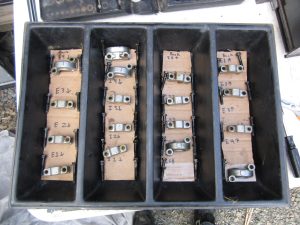
After the engine is out of the vehicle, the first step to a good rebuild is teardown and cleanup. It is during this process that you are doing your first visual inspection of each part. As it is likely you do not do this every day, you should take meticulous notes of how everything goes back together and label bolts and parts. Once everything is dismantled, all the parts should be thoroughly cleaned. You might be lucky enough to have a bead blaster or parts washer in your garage, but more than likely, you will be scrubbing parts and spraying endless streams of brake cleaner. Now for the second inspection, look at wear patterns, cracks, and any defects. The wear patterns and typical crack locations are different for every type of engine. Make sure you do your research to know what to look for.
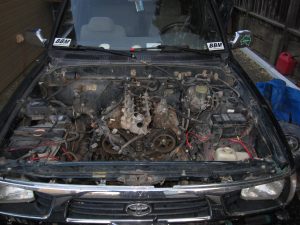
On the 5VZ engines, there is an engine block water and oil galley plug that should be removed before going into the hot tank. This is a step that is near impossible in a DIY situation, and not even most machine shops would be able to perform it. The 5VZ uses small stainless-steel balls as oil galley plugs, and most shops can’t, won’t, or don’t remove them because once they have been removed, they are not reusable, and good luck finding replacements. However, it is important to remove these as it is impossible to remove all contaminants behind these galleys without removing the plugs. This is one of those steps that only a shop that works on these engines all the time would even think to do. This is why you should have a shop that knows your engine brand to do your rebuild. If you have a Jeep engine, go to a Jeep guy, don’t get it from Yota1; but if you have a Toyota engine, get it from Yota1. Also, make sure to read and give reviews.
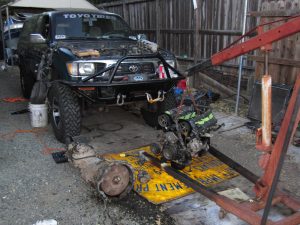
Everything is now clean. You have identified any parts that need to be replaced, and it is off to the machine shop. It is in the machine shop that an engine rebuild goes from ok to great. If you are thinking of rebuilding an engine yourself, take the information below to your local machine shop to get a quote for the work. Ask them if they can and would do all the steps that I am about to detail for you. Starting with the most important step of testing! Each part should be measured that it is and will still be in factory specification after machining is done. There can be defects in the parts that cannot be seen with the naked eye that can cause your engine to fail prematurely. This is why each part that could have cracks and minor defects should be Magnafluxed, mainly the engine block. Magna-flux is a process of exposing the components to a magnetic field and an iron powder to locate any cracks and defects. Cylinder heads should also be pressure checked by lowering them into a specialized machine that submerges the head underwater while the water jacket is pressurized, allowing even the smallest of cracks to be found. You could rig up some block-off plates and use a plastic tote with compressed air to do this yourself. Block-off plates are basic, but the bottom surface of the head needs to be completely covered except for a large hole to allow access to the combination chamber areas. Most cracks in the 5VZ heads are in the combination chamber, either between the valve seats or from the valve seat to the spark plug hole. Yota1 does all of this to each core, and if any defects are found, they are sent to the scrap bin, and another core is used, or the head is replaced with a brand new one. If the engine you are rebuilding has defects, you are dipping into your budget to find new parts, as it is likely you don’t have access to a bin of core parts. Once the parts have passed the testing, they can move on to the actual machining work.

We will start at the bottom and work our way up. The Crankshaft Mainline surfaces need to be checked and line honed. Cylinder Walls should be bored and honed to allow for proper piston ring sealing, thus helping with oil consumption and longevity. You will need to know the exact size the machine shop bored over your cylinder walls to be able to match the correct size pistons. The same with the crankshaft; if the crankshaft is ground, not just cleaned, checked, and polished, it will require different size rods and main bearings. Note: the crankshaft thrust bearing surfaces is not often ground, as it is so rarely required that it is hard to find bearings, and it is easier to find a new crank than an oversize bearing. Thus, the thrust-bearing surface is often just “cheeked,” which basically means polished.
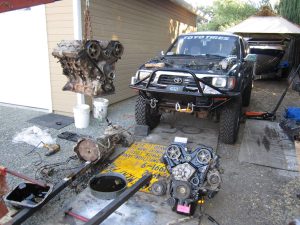 This brings up a good point about specifications in the rebuilding process. Any professional engine builder who stands behind their work will provide you with a build sheet. This sheet will include how much was machined off every surface, R/A ratings, and much more. If you are getting a full long block or short block rebuild, this info is useful for you to make sure the machine shop is properly measuring the piston to the wall and that the oil clearance is correct. If you are just getting machine work done before the spec sheet is produced, you will get a pre-bore done so you can order the correct pistons and rings. Then once the machine shop has the correct pistons, they will measure them to put the finish hone to spec and record those numbers. Often unknown and overlooked is the Roughness Average (R/A) of the cylinder wall honing that directly relates to the piston ring you use. The cylinder wall honing must be matched to the piston ring R/A specification from the piston ring manufacturer to prevent oil consumption. The R/A is measured with a profilometer that gives a lot of other information that is important, like RPK, RVK, and other acronyms that don’t mean anything to someone who is not a machinist. However, all these readouts are very important to the rings and head gasket surfaces. All these acronym specifications should match the parts manufactures specifications. It is also very important to know that not all manufacturers’ specifications are the same, and you cannot just buy any .20 over piston and expect it to fit correctly. A .20 piston from one manufacturer might measure differently than another manufactures .20 piston. It may only be 1000s of an inch off, but inside an engine, that is huge. Thus, it is very important to work with your machinist when ordering pistons, rings, and bearings to make sure the sizes and R/A match. It is also important to make sure that the machine shop uses a Torque plate while honing the cylinder walls so the block is at operating specification. This is due to the proximity of the head bolts to the cylinder wall. When the bolts are torqued down, it can distort the metal just enough to make the cylinders out of round. The block deck should also be machine straight, but only if it is within factory tolerances. If the block deck or cylinder head is machined too much, it will affect valve timing, causing your valves not to be fully closed when the spark is fired. Note: valve timing is not the same as ignition timing. Make sure you talk with your machinist about what type of head gasket, MLS, or composite you plan on using, as this may change the R/A that is required when surfacing the block to create a proper seal.
This brings up a good point about specifications in the rebuilding process. Any professional engine builder who stands behind their work will provide you with a build sheet. This sheet will include how much was machined off every surface, R/A ratings, and much more. If you are getting a full long block or short block rebuild, this info is useful for you to make sure the machine shop is properly measuring the piston to the wall and that the oil clearance is correct. If you are just getting machine work done before the spec sheet is produced, you will get a pre-bore done so you can order the correct pistons and rings. Then once the machine shop has the correct pistons, they will measure them to put the finish hone to spec and record those numbers. Often unknown and overlooked is the Roughness Average (R/A) of the cylinder wall honing that directly relates to the piston ring you use. The cylinder wall honing must be matched to the piston ring R/A specification from the piston ring manufacturer to prevent oil consumption. The R/A is measured with a profilometer that gives a lot of other information that is important, like RPK, RVK, and other acronyms that don’t mean anything to someone who is not a machinist. However, all these readouts are very important to the rings and head gasket surfaces. All these acronym specifications should match the parts manufactures specifications. It is also very important to know that not all manufacturers’ specifications are the same, and you cannot just buy any .20 over piston and expect it to fit correctly. A .20 piston from one manufacturer might measure differently than another manufactures .20 piston. It may only be 1000s of an inch off, but inside an engine, that is huge. Thus, it is very important to work with your machinist when ordering pistons, rings, and bearings to make sure the sizes and R/A match. It is also important to make sure that the machine shop uses a Torque plate while honing the cylinder walls so the block is at operating specification. This is due to the proximity of the head bolts to the cylinder wall. When the bolts are torqued down, it can distort the metal just enough to make the cylinders out of round. The block deck should also be machine straight, but only if it is within factory tolerances. If the block deck or cylinder head is machined too much, it will affect valve timing, causing your valves not to be fully closed when the spark is fired. Note: valve timing is not the same as ignition timing. Make sure you talk with your machinist about what type of head gasket, MLS, or composite you plan on using, as this may change the R/A that is required when surfacing the block to create a proper seal.
Now we will get into the Cylinder Heads, which are just as much, if not more, work than the block. We already talked about the machining of the block to the head surface and how that will affect valve timing if over-machined. Well, what else should be looked at when talking about valves? The valves should be ground, valve seats cut, valve tips ground and valve adjustments should all be made or checked. When working with your machinist, it is important to make sure that they are using a valve-cutting machine, not grounding the valves by hand. This is an old-school and DIY mechanic technique, but some machinists still grind valves by hand. Did the cylinder head have a burnt valve? Some say it is required to change all the valve seats in the head if one seat is bad and causes a burnt valve. Well, the good news is it is not necessary to change all the seats. You only need to change the seat on the valve that was burnt, so hopefully, that will save you some cash. If the machinist does not have a valve cutting machine, then Tig welding out the seat is one option to remove a bad seat. The best is to use a valve-cutting machine to cut out the bad seat. Then, a new seat will need to be pressed in and cut to match the valves. Tipping the valves is where the end of the valve is machined flat. It is important to know if your machinist tips the valve, as this will affect the valve adjustment. Then, a valve adjustment should be done on the head even if the valves were not tipped, and most machine shops will charge extra for a valve adjustment. It is also important to note that the cams and shim should be kept with the head throughout the machining process, mainly for valve adjustments. Since we are mainly talking about the 5VZ in this article, on a 5VZ, the intake surface often is corroded around the water jackets. 99.9% of shops will not do anything more than clean the intake surface, but this surface can be machined with proper tooling. Also, the 5VZ camshafts have an oil plug in the end, the same as many other Toyota engines. Just like the engine block, the oil plug must be removed to be able to properly clean the internal oil pathways. When the camshaft is polished, as any good machinist will do, contaminants will get inside the camshaft. If the oil plug is not removed, it is impossible to remove all those contaminates, not to mention the 300,000 miles of other crud built up inside of it. Lastly, all the thread holes should be cleaned and properly repaired if needed.
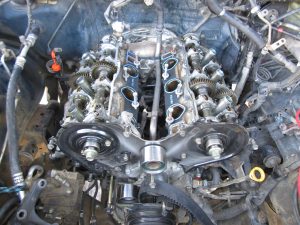
Ok, now you are ready to assemble! You made sure your pistons and rings are matched to your cylinder bore and R/A, the valves are ground, and your camshafts are polished. How much do you have left in your budget? Are you going to use all OEM parts? Did you do your research on the parts that are not available from the factory anymore? Do you have your torque spec sheet and torque wrench handy? Do you have any special tools that are needed to correctly install parts? Ready, set, go, and slap it all back together! I hope it runs; no warranty and no support if it does not. If you can do everything listed above, more power to you, and I wish I could say I could. Sometimes you just need to know when to let the professionals handle things. Find a quality rebuilder that knows your engine, uses factory OEM parts, and the best of the aftermarket parts.
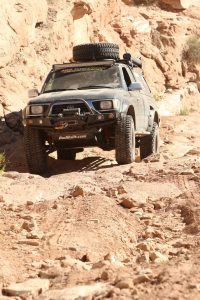
WRAP UP
Be careful if you plan on purchasing and installing any used JDM or USA engine. Most JDM engines were not treated with respect and likely will not just reset your mileage clock like I thought it would when I was young. I was burned hard by a JDM engine, and the more research I did, the more I found others in the same situation. If you can find a low-mileage USA engine with a maintenance history, grab it; low mileage in the USA is normally under 150,000 these days, which is still a lot of miles. Is it worth your time?
Do you want to rebuild your engine after reading the above? There are so many more details that go into rebuilding an engine than I would have ever thought before I did my research. I had no idea about all the machining work that goes into the engine block and cylinder heads. Cylinder wall honing, deck surfacing, roughness average testing, valve job, cylinder head surfacing, matching pistons to cylinder wall clearance, matching piston rings to roughness average, and removing the oil galley plugs, just to list a few. Then the testing and inspections that a true engine remanufacture does with each part to make sure that bad parts are not reused. There is no way that you would be able to purchase all the factory parts that are required to rebuild your engine and come within budget. You will have to cut some corners or use subpar aftermarket replacement parts. When you add up all the parts and cost of machine work, you will be so close, if not over the cost of a remanufactured engine. For my money, I would rather have someone who knows every detail of that engine rebuild it so I can focus on taking my rig on adventures.



